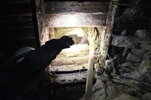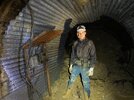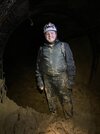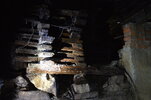This place was truly impressive and I'd definitely recommend a visit to anyone. In total we spent around 4 hours inside here and still didn't explore every passageway - so a return visit will be in order. It is worth mentioning that although we hadn't read anything about bad air in this system, we now always carry as 4-gas detector with us when going underground to be on the safe side - although the detector said that the air was good through this system, always take the necessary precautions if you're going down a mine.
You can check out all my photos from this explore here on my Flickr.
Background:
Sallet Hole was originally driven as a sough to the workings under Longstone Edge, before being modified into a haulage level in 1840-42. A 32ft diameter waterwheel originally powered crushing rollers here, but all traces of it have been destroyed by later workings. In the C20th, Sallet Hole Mine was worked for fluorspar, first from 1926-30, and then from 1965. It worked Deep Rake below the depth of the opencast workings on Longstone Edge, and in 1990 produced 73,000 tonnes of ore.
It finally closed in 1998, and water still flows from it today.
The explore:
Originally we had tried to enter Sallet Hole No.2 (Watersaw Mine) via an entrance that exists a few miles away but sadly had been unable to do so due to machinery that seemed to be working within the area around the entrance to the mine. We'd also heard that a large collapse between Sallet Hole No.1 and No.2 (Watersaw) had stopped them both joining, so a trip to Sallet Hole No.2 may be worth a visit sometime to explore this side of the workings.
After leaving the car in a public carpark, we began the 20+ minute walk to the entrance to the mine. Immediately it was clear that this was going to be a wet and muddy explore, given the amount of water that was flowing from under the doorway. Gaining access was easy and we were soon inside.

Once inside the mine opens up to a very long corridor that seems to go on and on for sometime. A local had told us on our walk up that vehicles would drive into the workings of the mine and this was clear from the tracks left inside where we were walking:



We contintinued to walk for some time, which by this point had led to us walking in ankle deep water - but this was only the beginning of the water.... Following a photo guide that we had found online, eventually came to the medical room that would have served the working mine, complete with the electrical wires and machines that had been left behind after the mines closure. At this point, you can take three pathways, of which we explored two: (1) the medical centre and a dead end and (2) through a briefly flooded section that led onwards to our further explore. The third pathway that we didn't fully explore leads to a collapse section that, if you're brave enough, was possible to clamber over and further explore - but we didn't quite fancy that today! The medical centre was a good place to stop and take a moment before continuing deeper into the workings:



If you do visit here, you 100 percent need wellies or at the very least good waterproof boots otherwise your feet WILL get wet! There were a few flooded sections that we had to navigate through, luckily there were often somewhat sturdy pipes to stand on in the edge. I went ahead at one point, being the only one with wellies that were long enough to prevent my feet getting wet. Sadly though this route led to a dead end and retraced our steps back to the medical centre to take a different route:

Although a dead end, there were some really cool old tipper cars to get some snaps of and a long hole that led all the way to what seemed to be the surface. Next to it was a contrainer with a hook ontop, so I can only presume that this was how certain materials were taken to the surface:


Now, the most intersting but SCARY part of the whole explore was reaching, what the explorer whos guide we were following, had called the 'ladders of death'. We'd seen photos of these ladders but wow, in person they looked even more sketchy. In order to continue our explore we knew we had to build up some courage and climb the ladders (as all other routes on this level were a dead end). The ladders would take us from level 150m to 130m. There were three ladders to climb, all of which had a rotting false floor between them. So, up we went:



After conquring the ladders we were immediatly greeted with a sole mine cart on some rails and a very big drop, we imagined this was where the tipper carts would drop their contents down to another level:

Level 130m was even worse than 150m in terms of tackling the mud. Progress was at time painfully slow as we did our best to not let our footwear be swallowed by the mud, even in wellies I was stuggling at times. You can see just how deep the mud is around this tipper car:

We eventually reached a small alcove that was home to a fuse box and light. We'd already been in the mine for around 3 hours at this point the three of us decided to call it a day and head back out and let our outside contacts know that we were okay before they got worried. At the point we got to the only way to continue your explore is by ascending or descending another set of ladders, which we'd read were around 3x as long as the first set we had climbed earlier! We were pretty confident in our abilities, but thought today wasn't the time to attempt this second set, which looked even more unsafe than the first. Ascending the ladder should lead to an old 'canteen' that the miners would've taken restbreaks at, complete with old cans of food and drink still preserved for photography. We'll return here another time and continue our explore.

You can check out all my photos from this explore here on my Flickr.
Background:
Sallet Hole was originally driven as a sough to the workings under Longstone Edge, before being modified into a haulage level in 1840-42. A 32ft diameter waterwheel originally powered crushing rollers here, but all traces of it have been destroyed by later workings. In the C20th, Sallet Hole Mine was worked for fluorspar, first from 1926-30, and then from 1965. It worked Deep Rake below the depth of the opencast workings on Longstone Edge, and in 1990 produced 73,000 tonnes of ore.
It finally closed in 1998, and water still flows from it today.
The explore:
Originally we had tried to enter Sallet Hole No.2 (Watersaw Mine) via an entrance that exists a few miles away but sadly had been unable to do so due to machinery that seemed to be working within the area around the entrance to the mine. We'd also heard that a large collapse between Sallet Hole No.1 and No.2 (Watersaw) had stopped them both joining, so a trip to Sallet Hole No.2 may be worth a visit sometime to explore this side of the workings.
After leaving the car in a public carpark, we began the 20+ minute walk to the entrance to the mine. Immediately it was clear that this was going to be a wet and muddy explore, given the amount of water that was flowing from under the doorway. Gaining access was easy and we were soon inside.
Once inside the mine opens up to a very long corridor that seems to go on and on for sometime. A local had told us on our walk up that vehicles would drive into the workings of the mine and this was clear from the tracks left inside where we were walking:
We contintinued to walk for some time, which by this point had led to us walking in ankle deep water - but this was only the beginning of the water.... Following a photo guide that we had found online, eventually came to the medical room that would have served the working mine, complete with the electrical wires and machines that had been left behind after the mines closure. At this point, you can take three pathways, of which we explored two: (1) the medical centre and a dead end and (2) through a briefly flooded section that led onwards to our further explore. The third pathway that we didn't fully explore leads to a collapse section that, if you're brave enough, was possible to clamber over and further explore - but we didn't quite fancy that today! The medical centre was a good place to stop and take a moment before continuing deeper into the workings:
If you do visit here, you 100 percent need wellies or at the very least good waterproof boots otherwise your feet WILL get wet! There were a few flooded sections that we had to navigate through, luckily there were often somewhat sturdy pipes to stand on in the edge. I went ahead at one point, being the only one with wellies that were long enough to prevent my feet getting wet. Sadly though this route led to a dead end and retraced our steps back to the medical centre to take a different route:
Although a dead end, there were some really cool old tipper cars to get some snaps of and a long hole that led all the way to what seemed to be the surface. Next to it was a contrainer with a hook ontop, so I can only presume that this was how certain materials were taken to the surface:
Now, the most intersting but SCARY part of the whole explore was reaching, what the explorer whos guide we were following, had called the 'ladders of death'. We'd seen photos of these ladders but wow, in person they looked even more sketchy. In order to continue our explore we knew we had to build up some courage and climb the ladders (as all other routes on this level were a dead end). The ladders would take us from level 150m to 130m. There were three ladders to climb, all of which had a rotting false floor between them. So, up we went:
After conquring the ladders we were immediatly greeted with a sole mine cart on some rails and a very big drop, we imagined this was where the tipper carts would drop their contents down to another level:
Level 130m was even worse than 150m in terms of tackling the mud. Progress was at time painfully slow as we did our best to not let our footwear be swallowed by the mud, even in wellies I was stuggling at times. You can see just how deep the mud is around this tipper car:
We eventually reached a small alcove that was home to a fuse box and light. We'd already been in the mine for around 3 hours at this point the three of us decided to call it a day and head back out and let our outside contacts know that we were okay before they got worried. At the point we got to the only way to continue your explore is by ascending or descending another set of ladders, which we'd read were around 3x as long as the first set we had climbed earlier! We were pretty confident in our abilities, but thought today wasn't the time to attempt this second set, which looked even more unsafe than the first. Ascending the ladder should lead to an old 'canteen' that the miners would've taken restbreaks at, complete with old cans of food and drink still preserved for photography. We'll return here another time and continue our explore.
Attachments
Last edited:





